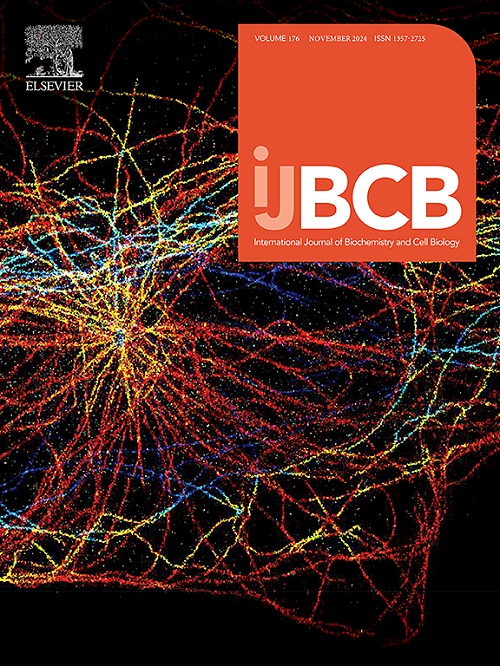ASPSCR1::TFE3-mediated upregulation of insulin receptor substrate 2 (IRS-2) activates PI3K/AKT signaling and promotes malignant phenotype
IF 3.4
3区 生物学
Q2 BIOCHEMISTRY & MOLECULAR BIOLOGY
International Journal of Biochemistry & Cell Biology
Pub Date : 2024-10-16
DOI:10.1016/j.biocel.2024.106676
引用次数: 0
Abstract
The ASPSCR1::TFE3 fusion gene, resulting from chromosomal translocation, is detected in alveolar soft part sarcoma (ASPS) and a subset of renal cell carcinomas (RCC). The ASPSCR1::TFE3 oncoprotein, functioning as an aberrant transcription factor, contributes to tumor development and progression by inappropriately upregulating target genes. Here, we identified insulin receptor substrate 2 (IRS-2), a cytoplasmic adaptor protein, as a novel transcriptional target of ASPSCR1::TFE3. Ectopic expression of ASPSCR1::TFE3 led to increased IRS-2 mRNA and protein levels. Chromatin immunoprecipitation and luciferase assays demonstrated that ASPSCR1::TFE3 bound to the IRS-2 promoter region and enhanced its transcription. Moreover, IRS-2 was highly expressed in the ASPSCR1::TFE3-positive RCC cell line FU-UR1, while small interfering RNA-mediated depletion of ASPSCR1::TFE3 markedly decreased IRS-2 mRNA and protein levels. Functionally, IRS-2 knockdown attenuated activation of the PI3K/AKT pathway and reduced proliferation, migration, invasion, adhesion, and clonogenicity in FU-UR1 cells. Pharmacological inhibition of IRS-2 also reduced AKT activation as well as cell viability, clonogenicity, migration, invasion, and adhesion. These findings suggest that IRS-2, regulated by ASPSCR1::TFE3, promotes tumor progression by activating PI3K/AKT signaling and enhancing the malignant phenotype.
ASPSCR1::TFE3介导的胰岛素受体底物2(IRS-2)上调激活了PI3K/AKT信号转导,并促进了恶性表型的形成。
在肺泡软组织肉瘤(ASPS)和部分肾细胞癌(RCC)中发现了染色体易位产生的 ASPSCR1::TFE3 融合基因。ASPSCR1::TFE3肿瘤蛋白作为一种异常转录因子,通过不适当地上调靶基因来促进肿瘤的发生和发展。在这里,我们发现细胞质适配蛋白胰岛素受体底物2(IRS-2)是ASPSCR1::TFE3的一个新的转录靶标。异位表达ASPSCR1::TFE3导致IRS-2 mRNA和蛋白水平升高。染色质免疫共沉淀和荧光素酶试验证明,ASPSCR1::TFE3与IRS-2启动子区域结合并增强了其转录。此外,IRS-2在ASPSCR1::TFE3阳性的RCC细胞系FU-UR1中高表达,而小干扰RNA介导的ASPSCR1::TFE3去除可显著降低IRS-2 mRNA和蛋白水平。在功能上,IRS-2敲除可减轻PI3K/AKT通路的激活,降低FU-UR1细胞的增殖、迁移、侵袭、粘附和克隆性。药理抑制 IRS-2 也会降低 AKT 的活化以及细胞活力、迁移、侵袭和粘附性。这些发现表明,IRS-2受ASPSCR1::TFE3调控,通过激活PI3K/AKT信号和增强恶性表型促进肿瘤进展。
本文章由计算机程序翻译,如有差异,请以英文原文为准。
求助全文
约1分钟内获得全文
求助全文
来源期刊
CiteScore
8.10
自引率
0.00%
发文量
124
审稿时长
19 days
期刊介绍:
IJBCB publishes original research articles, invited reviews and in-focus articles in all areas of cell and molecular biology and biomedical research.
Topics of interest include, but are not limited to:
-Mechanistic studies of cells, cell organelles, sub-cellular molecular pathways and metabolism
-Novel insights into disease pathogenesis
-Nanotechnology with implication to biological and medical processes
-Genomics and bioinformatics

 求助内容:
求助内容: 应助结果提醒方式:
应助结果提醒方式:


